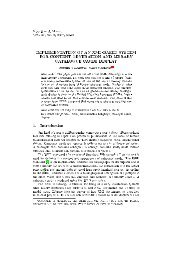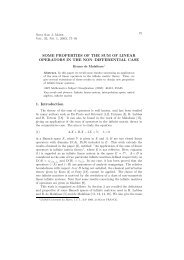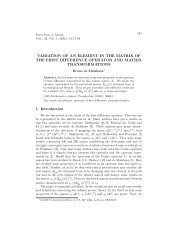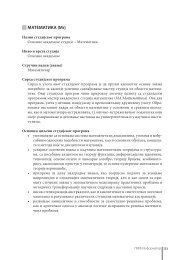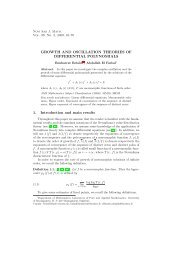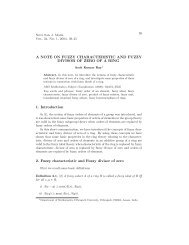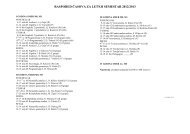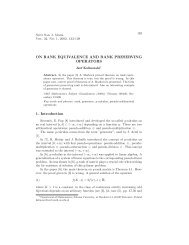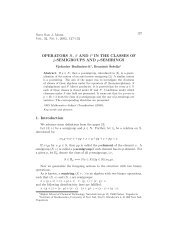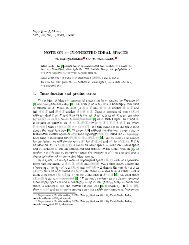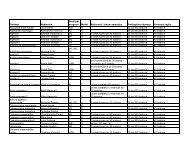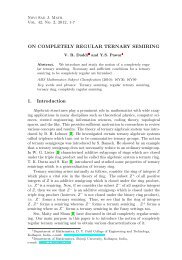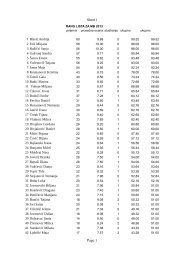On enumerating transformation semigroups
On enumerating transformation semigroups
On enumerating transformation semigroups
Create successful ePaper yourself
Turn your PDF publications into a flip-book with our unique Google optimized e-Paper software.
<strong>On</strong> Enumerating Sub<strong>semigroups</strong> of the Full<br />
Transformation Semigroup<br />
Attila Egri-Nagy<br />
joint work with James East (Univ. of Western Sydney) and James D.<br />
Mitchell (University of St. Andrews, Scotland)<br />
2013.06.08. Novi Sad Algebra Conference<br />
e-n@ (UWS) Subsemigroup Enumeration NSAC 2013 1 / 31
Motivation<br />
Practical need: to have a library of small <strong>transformation</strong> <strong>semigroups</strong>.<br />
Personally, I am looking for interesting holonomy decompositions.<br />
e-n@ (UWS) Subsemigroup Enumeration NSAC 2013 2 / 31
Semigroup enumeration and classification<br />
Problems:<br />
There are lots of <strong>semigroups</strong>.<br />
Most of them are 3-nilpotent, i.e. they satisfy the xyz = 0 identity.<br />
“So, whereas groups are gems, all of them precious, the garden<br />
of <strong>semigroups</strong> is filled with weeds. <strong>On</strong>e needs to yank out these<br />
weeds to find the interesting <strong>semigroups</strong>.”<br />
Rhodes, J., Steinberg, B.: The q-theory of Finite Semigroups. Springer<br />
(2008)<br />
So, it is useless and hopeless.<br />
e-n@ (UWS) Subsemigroup Enumeration NSAC 2013 3 / 31
History of semigroup enumeration<br />
1955 Forsythe, G. E., SWAC computes 126 distinct <strong>semigroups</strong> of<br />
order 4, Proc. Amer. Math. Soc., 6 (1955), 443–447.<br />
Tetsuya, K., Hashimoto, T., Akazawa, T., Shibata, R., Inui, T. and<br />
Tamura, T., All <strong>semigroups</strong> of order at most 5, J. Gakugei<br />
Tokushima Univ. Nat. Sci. Math., 6 (1955), 19–39.<br />
1967 Plemmons, R. J., There are 15973 <strong>semigroups</strong> of order 6, Math.<br />
Algorithms, 2 (1967), 2–17.<br />
1977 Jürgensen, H. and Wick, P., Die Halbgruppen der Ordnungen ≤ 7,<br />
Semigroup Forum, 14 (1) (1977), 69–79.<br />
1994 Satoh, S., Yama, K. and Tokizawa, M., Semigroups of order 8,<br />
Semigroup Forum, 49 (1) (1994), 7–29.<br />
e-n@ (UWS) Subsemigroup Enumeration NSAC 2013 4 / 31
Current state of semigroup enumeration<br />
Inspired by the SmallGroups Library for GAP and Magma there is<br />
now a GAP package called Smallsemi.<br />
Smallsemi provides a database of all the small <strong>semigroups</strong> up to order 8,<br />
tools for identifying <strong>semigroups</strong> and their properties (e.g. commutative,<br />
band, inverse, regular, etc., 16 of them in total ).<br />
The size of the compressed database is 22 Mbytes.<br />
Andreas Distler, James D. Mitchell<br />
http://www-groups.mcs.st-andrews.ac.uk/~jamesm/smallsemi/<br />
e-n@ (UWS) Subsemigroup Enumeration NSAC 2013 5 / 31
Number of <strong>semigroups</strong> of order n<br />
order #groups #<strong>semigroups</strong> #3-nilpotent <strong>semigroups</strong><br />
1 1 1 0<br />
2 1 4 0<br />
3 1 18 1<br />
4 2 126 8<br />
5 1 1,160 84<br />
6 2 15,973 2,660<br />
7 1 836,021 609,797<br />
8 5 1,843,120,128 1,831,687,022<br />
9 2 52,989,400,714,478 52,966,239,062,973<br />
The calculation was done by combining GAP and a Constraint<br />
Satisfaction Problem (CSP) solver Minion minion.sf.net.<br />
e-n@ (UWS) Subsemigroup Enumeration NSAC 2013 6 / 31
Enumerating <strong>transformation</strong> <strong>semigroups</strong><br />
Idea: Find the sub<strong>semigroups</strong> of the full <strong>transformation</strong> semigroup.<br />
Straightforward brute-force algorithm: enumerate all subsets of T n and<br />
keep those that form a subsemigroup.<br />
However, there are 2 nn subsets of T n .<br />
n n n 2 nn<br />
1 1 2<br />
2 4 16<br />
3 27 134217728<br />
4 256<br />
11579208923731619542357098500<br />
86879078532699846656405640394<br />
57584007913129639936<br />
5 3125 2 3125<br />
e-n@ (UWS) Subsemigroup Enumeration NSAC 2013 7 / 31
We know lot more about permutation groups<br />
Subgroups of S n<br />
n #distinct subgroups #conjugacy classes<br />
1 1 1<br />
2 2 2<br />
3 6 4<br />
4 30 11<br />
5 156 19<br />
6 1455 56<br />
7 11300 96<br />
8 151221 296<br />
9 1694723 554<br />
10 29594446 1593<br />
11 404126228 3094<br />
12 10594925360 10723<br />
13 175238308453 20832<br />
A000638 and A005432 on oeis.org.<br />
e-n@ (UWS) Subsemigroup Enumeration NSAC 2013 8 / 31
All sub<strong>semigroups</strong> of T 2<br />
1 ↦→ [1, 1], 2 ↦→ [1, 2], 3 ↦→ [2, 1], 4 ↦→ [2, 2]<br />
1144<br />
1234<br />
1324<br />
,<br />
1414<br />
1144<br />
1234<br />
1324<br />
,<br />
1414<br />
1144<br />
1234<br />
1324<br />
,<br />
1414<br />
1144<br />
1234<br />
1324<br />
,<br />
1414<br />
1144<br />
1234<br />
1324<br />
,<br />
1414<br />
1144<br />
1234<br />
1324<br />
,<br />
1414<br />
1144<br />
1234<br />
1324<br />
,<br />
1414<br />
1144<br />
1234<br />
1324<br />
,<br />
1414<br />
1144<br />
1234<br />
1324<br />
1414<br />
{} ↦→ {[11], [12], [21], [22]}<br />
{3} ↦→ {[11], [12], [22]}<br />
{1, 4} ↦→ {[12], [21]}<br />
{1, 3} ↦→ {[12], [22]} {2, 3} ↦→ {[11], [22]} {3, 4} ↦→ {[11], [12]}<br />
{1, 3, 4} ↦→ {[12]}<br />
{1, 2, 3} ↦→ {[22]}<br />
{2, 3, 4}, {[11]}<br />
e-n@ (UWS) Subsemigroup Enumeration NSAC 2013 9 / 31
Idea: systematic reduction of multiplication tables<br />
Let S be a semigroup, n = |S|. We fix an order on the semigroup elements,<br />
s 1 , . . . , s n , thus we can easily refer to the elements by their indices.<br />
Definition<br />
Then the multiplication table of S is a n × n matrix M with entries from<br />
{1, .., n} such that M i,j = k if s i s j = s k . This table is often called the<br />
Cayley-table of the semigroup.<br />
Definition (cut, closed cut)<br />
A cut is a subset of the semigroup, K ⊆ S a set elements that we cut from<br />
the M. A cut is closed if the table spanned by S \ K is a multiplication<br />
table, i.e. it is closed under multiplication.<br />
e-n@ (UWS) Subsemigroup Enumeration NSAC 2013 10 / 31
Forbidden Elements<br />
Definition (Forbidden Elements)<br />
F (K) = {i ∈ S \ K | ∃j ∈ S \ K such that M i,j ∈ K or M j,i ∈ K}<br />
i.e. those elements not in the cut, whose column or row contains an<br />
element in the cut.<br />
e-n@ (UWS) Subsemigroup Enumeration NSAC 2013 11 / 31
Example: S 3<br />
Consider S 3 with the ordering: (), (2,3), (1,2), (1,2,3), (1,3,2), (1,3).<br />
The cut K = {2} (i.e. removing (2,3)) is not a closed one.<br />
F (K) = {3, 4, 5, 6}<br />
K extended by the forbidden elements K ∪ F (K) = {2, 3, 4, 5, 6} is closed.<br />
1 2 3 4 5 6<br />
2 1 4 3 6 5<br />
3 5 1 6 2 4<br />
4 6 2 5 1 3<br />
5 3 6 1 4 2<br />
6 4 5 2 3 1<br />
e-n@ (UWS) Subsemigroup Enumeration NSAC 2013 12 / 31
Problem<br />
The closed cut K ∪ F (K) corresponds to the trivial subgroup. However<br />
there are more closed cuts including K: {2, 3, 6}, {2, 3, 4, 5},{2, 4, 5, 6}.<br />
123456<br />
214365<br />
351624<br />
462513<br />
536142<br />
645231<br />
123456<br />
214365<br />
351624<br />
462513<br />
536142<br />
645231<br />
123456<br />
214365<br />
351624<br />
462513<br />
536142<br />
645231<br />
This means that we have to extend the cut one by one with the elements<br />
from the completion. Therefore we are back to the brute-force algorithm<br />
(actually even less efficient).<br />
e-n@ (UWS) Subsemigroup Enumeration NSAC 2013 13 / 31
Heuristics<br />
1 Diagonal closure.<br />
2 “Rescuing”<br />
3 Conjugacy.<br />
4 Dynamic programming.<br />
e-n@ (UWS) Subsemigroup Enumeration NSAC 2013 14 / 31
Definition (diagonal completion of a cut)<br />
D(K) = {i ∈ S \ K | M i,i ∈ K}<br />
i.e. those elements not in the cut, whose diagonal contains an element in<br />
the cut.<br />
e-n@ (UWS) Subsemigroup Enumeration NSAC 2013 15 / 31
The diagonal closure of a cut<br />
Iterating<br />
∆(K) := K ∪ D(K)<br />
Since cutting an element from a diagonal can be done only one way, we<br />
can extend the cut by its diagonal completion.<br />
Algorithm 1: Calculating the diagonal closure of a cut.<br />
input : M multiplication table, K a cut<br />
output: K extended to ∆(K)<br />
repeat<br />
finished ← true;<br />
for i ∈ S \ K do<br />
if M i,i ∈ K then<br />
K ← K ∪ {i};<br />
finished ← false;<br />
until finished;<br />
e-n@ (UWS) Subsemigroup Enumeration NSAC 2013 16 / 31
Again using the multiplication table of S 3 if we cut by K = {5} we get the<br />
following table:<br />
1 2 3 4 5 6<br />
2 1 4 3 6 5<br />
3 5 1 6 2 4<br />
4 6 2 5 1 3<br />
5 3 6 1 4 2<br />
6 4 5 2 3 1<br />
5 appears in the diagonal for element 4, so ∆({5}) = {4, 5}. In this<br />
particular case ∆({4}) is also {4, 5}, but having the same closure is not a<br />
symmetric relation. For instance, ∆({1}) = {1, 2, 3, 6} but ∆({6}) = {6}.<br />
e-n@ (UWS) Subsemigroup Enumeration NSAC 2013 17 / 31
Exploiting symmetries<br />
We use the most traditional approach to conjugacy for <strong>semigroups</strong> and<br />
define G-conjugacy. Elements s, t ∈ S are G-conjugate, denoted by<br />
s ∼ G t, if s = g −1 tg for some g ∈ G.<br />
Here we act on the <strong>transformation</strong> representation.<br />
Ways to use conjugacy:<br />
Whenever we find a subsemigroup we take the orbit under<br />
conjugation.<br />
For a non-semigroup subset we can also use the conjugacy class to<br />
prune the underlying search tree.<br />
We start cutting only from conjugacy class representatives.<br />
. . . and of course we get the conjugacy classes as well.<br />
e-n@ (UWS) Subsemigroup Enumeration NSAC 2013 18 / 31
Conjugacy classes of sub<strong>semigroups</strong> of T 2<br />
1144<br />
1234<br />
1324<br />
1414<br />
1144<br />
1234<br />
1324<br />
1414<br />
1144<br />
1234<br />
1324<br />
1144<br />
1234<br />
1324<br />
1414<br />
1414<br />
1144<br />
1234<br />
1324<br />
,<br />
1414<br />
1144<br />
1234<br />
1324<br />
1414<br />
1144<br />
1234<br />
1324<br />
1414<br />
1144<br />
1234<br />
1324<br />
,<br />
1414<br />
1144<br />
1234<br />
1324<br />
,<br />
1414<br />
e-n@ (UWS) Subsemigroup Enumeration NSAC 2013 19 / 31
“Rescuing elements”<br />
Observation: There is a problem with trying to cut the identity from<br />
groups. After the diagonal closure the algorithm reverts back to full<br />
enumeration of the subsets of S \ ∆(K).<br />
The “rescue” set of s relative to cut K:<br />
R(K, F (K), s) := {i ∈ S \ K | M s,i ∈ F (K) or M i,s ∈ F (K)}<br />
What shall I remove if I want to keep s?<br />
e-n@ (UWS) Subsemigroup Enumeration NSAC 2013 20 / 31
How to measure complexity/efficiency?<br />
The number of visited cuts - the space complexity.<br />
The number of visited cuts and the number of revisits.<br />
S 3 #Cuts #Dups<br />
basic 63,63 103,41<br />
R 36,36 46,25<br />
∆ 17,17 31,17<br />
∆R 14,14 19,13<br />
T 2 #Cuts #Dups<br />
basic 13,13 11,9<br />
R 13,13 11,9<br />
∆ 11,11 11,9<br />
∆R 11,11 11,9<br />
e-n@ (UWS) Subsemigroup Enumeration NSAC 2013 21 / 31
Sing 3 #Cuts #Dups<br />
basic ? ?<br />
∆ 88555,88555 691298,116767<br />
R 6782,6782 20608,3672<br />
∆R 3764,3764 11764,2166<br />
T 3 #Cuts #Dups<br />
basic ? ?<br />
∆ 1505328,1505328 15670601,2629323<br />
R 44291,44291 206865,35713<br />
∆R 15664,15664 65104,11724<br />
e-n@ (UWS) Subsemigroup Enumeration NSAC 2013 22 / 31
Easy test cases: Cyclic Groups<br />
Cyclic groups - the number of subgroups is the number of divisors.<br />
Cyclic groups of prime order - just 2 subgroups, but there is a bit of<br />
n 2 3 5 7 11 13 17 19 23 29 31 37<br />
surprise.<br />
#cuts 2 3 3 7 3 3 7 3 7 3 48 3<br />
n 41 43 47 53 59 61 67 71 73 79 83 89<br />
#cuts 7 9 7 3 3 3 3 7 83 7 3 51<br />
n 97 101 103 107 109 113 127 131 137<br />
#cuts 7 3 7 3 9 11 786 3 7<br />
e-n@ (UWS) Subsemigroup Enumeration NSAC 2013 23 / 31
T 3 data, the sizes of sub<strong>semigroups</strong><br />
Order #occurences<br />
1 3<br />
2 10<br />
3 19<br />
4 28<br />
5 38<br />
6 42<br />
7 38<br />
8 30<br />
9 25<br />
10 14<br />
11 12<br />
Order #occurences<br />
12 7<br />
13 3<br />
14 1<br />
15 3<br />
16 2<br />
17 2<br />
21 1<br />
22 1<br />
23 1<br />
24 1<br />
27 1<br />
e-n@ (UWS) Subsemigroup Enumeration NSAC 2013 24 / 31
Summary of Results<br />
n 0 1 2 3 4<br />
S n - 1,1 2,2 6,4 30,11<br />
T n 1,1 2,2 10,8 1299,283<br />
T n \ S n 1,1 1,1 4,3 600,123<br />
A215650, A215651 http://oeis.org<br />
e-n@ (UWS) Subsemigroup Enumeration NSAC 2013 25 / 31
Progress with T 4<br />
K 4,2<br />
3788251 (≈ 3.8 million) sub<strong>semigroups</strong> in 162331 in conjugacy classes.<br />
213268743 (≈ 213 million) cuts checked, more than 10GB data, 80323087<br />
(≈ 80 million) revisits.<br />
This data will be used to build the subsemigroup lattice from the bottom.<br />
Also, once we have the sub<strong>semigroups</strong> of Sing 4 , we can just them together<br />
with the subgroups and see what they generate.<br />
Also, we can start from maximal subgroups.<br />
e-n@ (UWS) Subsemigroup Enumeration NSAC 2013 26 / 31
Distribution of elements in multiplication tables<br />
T 1<br />
Frequency #elements<br />
1 1<br />
T 2 2 2<br />
Frequency #elements<br />
6 2<br />
Frequency #elements<br />
6 6<br />
T 3<br />
24 18<br />
87 3<br />
T 4<br />
120 144<br />
408 36<br />
Frequency #elements<br />
24 24<br />
504 48<br />
2200 4<br />
e-n@ (UWS) Subsemigroup Enumeration NSAC 2013 27 / 31
Frequency #elements<br />
2820 900<br />
T 5<br />
3420 600<br />
120 120<br />
720 1200<br />
11020 200<br />
16720 100<br />
84245 5<br />
T 6 95760 7200<br />
720 720<br />
5040 10800<br />
22320 16200<br />
26640 7200<br />
78480 1800<br />
143280 1800<br />
363600 300<br />
445680 450<br />
795600 180<br />
4492656 6<br />
e-n@ (UWS) Subsemigroup Enumeration NSAC 2013 28 / 31
Non-synchronising <strong>transformation</strong> <strong>semigroups</strong><br />
#sub<strong>semigroups</strong> #conjugacy classes<br />
T 2 2 2<br />
T 3 64 20<br />
T 4 58610 3085<br />
e-n@ (UWS) Subsemigroup Enumeration NSAC 2013 29 / 31
What to expect?<br />
A software tool for finding sub<strong>semigroups</strong> of any <strong>transformation</strong> semigroup<br />
with less than ≈100 elements.<br />
A database of all <strong>transformation</strong> <strong>semigroups</strong> on n points.<br />
n ≤ 3 we have the data, included in the GAP package Semigroups.<br />
n = 4 It seems to be within reach with the same heuristics, just a bit<br />
more data juggling.<br />
n = 5 Probably the same idea may work with more new heuristics and<br />
solving big data handling difficulties.<br />
n = 6 Not with this idea.<br />
e-n@ (UWS) Subsemigroup Enumeration NSAC 2013 30 / 31
Thank You!<br />
Transformation (and other type) <strong>semigroups</strong> software<br />
Semigroups<br />
http://www-circa.mcs.st-and.ac.uk/~jamesm/citrus.php<br />
Group & semigroup decomposition software:<br />
<strong>On</strong> computational semigroup theory:<br />
SgpDec http://sgpdec.sf.net<br />
http://compsemi.wordpress.com<br />
e-n@ (UWS) Subsemigroup Enumeration NSAC 2013 31 / 31



